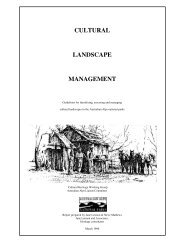Part 3 - Australian Alps National Parks
Part 3 - Australian Alps National Parks
Part 3 - Australian Alps National Parks
You also want an ePaper? Increase the reach of your titles
YUMPU automatically turns print PDFs into web optimized ePapers that Google loves.
Mountain Catchment Biomes As with mountain areas around the world the <strong>Australian</strong> <strong>Alps</strong> biomes are unique – the combined effect ofrapid changes in altitude, climate, soil and vegetation over very short distances make them different fromother biomes. An indication of the extreme climatic variation exhibited in all mountainous areas is that arise in elevation of 100 metres is comparable to about 100 kilometres change in latitude. The rapid risein elevation is sufficient to produce altitudinal zonation in the vegetation communities, particularly thatevident in the zonation of the dominant Eucalypts, with different species occurring in defined elevationranges and aspects.Catchment biological diversityMountains are biologically diverse and of the 187 world centres of biological diversity more than halfoccur in mountain regions (Davis et al, 1995). The <strong>Australian</strong> <strong>Alps</strong> are identified as one of these centreswith more than 500 plant species occurring within the <strong>Alps</strong> catchments of which 380 occur in the alpineand subalpine zones.Plant endemism is high in all mountain regions around the world, (about 5%). but plant endemism in the<strong>Australian</strong> <strong>Alps</strong> at approximately 11% (Good 1992), is of particular note in comparison to othercontinental mountain regions. The <strong>Alps</strong> flora, particularly the alpine zone flora is unique on a world scaleas it differs greatly in botanical composition, the level of differentiation, species richness and internalbotanical zonation. Below the very diverse alpine zone the flora is dominated by a single genus(Eucalyptus), which has adapted to conditions from the highest elevations of the subalpine zone (thetreeline) to the coast; this adaptation to the full elevation range and environmental conditions by a singlegenus is unique in the world floras.The eucalypt woodlands, particularly at the higher elevations play a very significant role in the capture ofprecipitation and hence water yield, and in the stability of much of the mountain catchments.While the number of native fauna species is low, which contrasts with other continental mountain areas,eight fauna species are endemic to the alpine and subalpine zones. Several of these species have restricteddistribution ranges in the <strong>Alps</strong> catchments. eg Mountain Pygmy Possum Burramy parvus, CorroboreeFrog Pseudophryne corroboree and Broad-toothed Rat Mastacomys fuscus. The <strong>Alps</strong> catchments as suchcapture, protect and maintain a unique genetic resource, but mountain catchments are more than waterand biodiversity catchments; they are catchments for human enjoyment, recreational and educational use,and inspiration.Educational and recreational – catchment opportunitiesThe diversity of the mountain landscapes provide for a wide range of recreational, educational, culturaland inspirational opportunities. The <strong>Alps</strong> attract and capture some 3 to 4 million visitors each year inpursuit of these opportunities.The <strong>Alps</strong> have also been a catchment for much scientific research over the past 100 years and are nowarguably, the most researched natural area in Australia. Over 2500 scientific and technical papers havebeen written on research undertaken within the <strong>Alps</strong> and this research has contributed greatly toecological understanding and the establishment of principles for ecological sustainability in Australia.Environmental resources and benefitsThe natural systems of the <strong>Alps</strong> catchments are very significant and in many ways unique in the contextof world mountain areas. A defining feature of the <strong>Alps</strong> catchments is the well developed soil coverwhich exists over almost all areas, to the highest peaks. This deep organic soil cover of the alpine andsubalpine zones plays an important role in catchment hydrology.The groundwater communities, the fen and bog areas where deep organic peatbeds have developed, areparticularly significant in the storage and slow release of snowmelt waters to the streams and rivers and222Celebrating Mountains – An International Year of Mountains ConferenceJindabyne, New South Wales, Australia
















